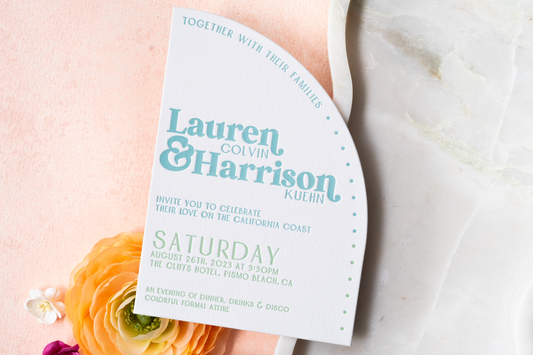When it comes to printing your wedding invitations, the method you choose can greatly impact the look, feel and cost of your stationery. Two of the most popular techniques are letterpress, which we specialize in here at Paper Sweet(!), and flat digital printing. Each style offers their own distinct advantages, so let's breakdown the difference and help you understand which style is right for you!
Letterpress Printing

Letterpress is a centuries-old technique that involves pressing inked designs into paper using a heavy press. This method creates a unique, luxurious texture that’s both visually and physically engaging.
Key Features of Letterpress Printing:
-
Indentation: The defining characteristic of letterpress is the deep impression it leaves on the paper. You can physically feel the indention where the inked design or text has been pressed, giving the invitation a three-dimensional quality.
-
Luxurious Materials: Letterpress is often paired with thick, cotton-based paper that enhances the tactile experience and holds the indention beautifully.
-
Customizable Ink Coverage: Each color is applied individually, allowing for vibrant, highly-pigmented designs but requiring precision and time.
-
Timeless Elegance: The depth and texture add a sense of sophistication that’s hard to replicate with other methods.
When to Choose Letterpress:
-
You want a high-end, classic look.
-
Texture and tactile appeal are priorities for your design.
-
You have a minimalist design or few colors to work with (as additional colors increase cost).
Flat Digital Printing
Flat digital printing is a modern, cost-effective method that involves applying ink directly onto the paper’s surface. Unlike letterpress, it does not create any physical indentation.

Key Features of Flat Digital Printing:
-
No Indentation: The ink lies flat on the paper, producing a smooth surface with no texture or depth.
-
Vibrant Colors and Gradients: Digital printing is ideal for intricate designs, full-color images, and gradients that might not be achievable with letterpress.
-
Versatile Paper Choices: While it can be done on a variety of papers, it’s best suited for thinner stock as thicker papers won’t have the same impact without texture.
-
Budget-Friendly: This method is more affordable than letterpress, making it accessible for couples with tighter budgets.
When to Choose Flat Digital Printing:
-
Your design features lots of colors, gradients, or photos.
-
You’re working within a specific budget.
-
You prefer a clean, modern, or minimalist aesthetic without texture.
Side-by-Side Comparison
| Feature | Letterpress | Flat Digital Printing |
|---|---|---|
| Indentation | Deep, tactile impressions | No indentation, smooth feel |
| Paper Thickness | Best on thick, luxe papers | Works on most paper types |
| Color Application | Limited colors, hand-mixed | Full-color capabilities |
| Cost | Premium pricing | More budget-friendly |
| Design Complexity | Best for simple designs | Handles complex designs |
Final Thoughts
Your choice between letterpress and flat digital printing depends on your priorities. If you’re seeking luxury and texture with a timeless appeal, letterpress is unmatched. On the other hand, flat digital printing offers versatility, vibrant colors, and affordability for modern designs.
No matter your choice, both methods can create stunning invitations that set the tone for your wedding day. If you’re still unsure, consider ordering samples to feel and see the difference firsthand—after all, your invitations are the first glimpse your guests will get of your special day!





